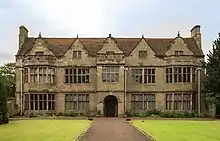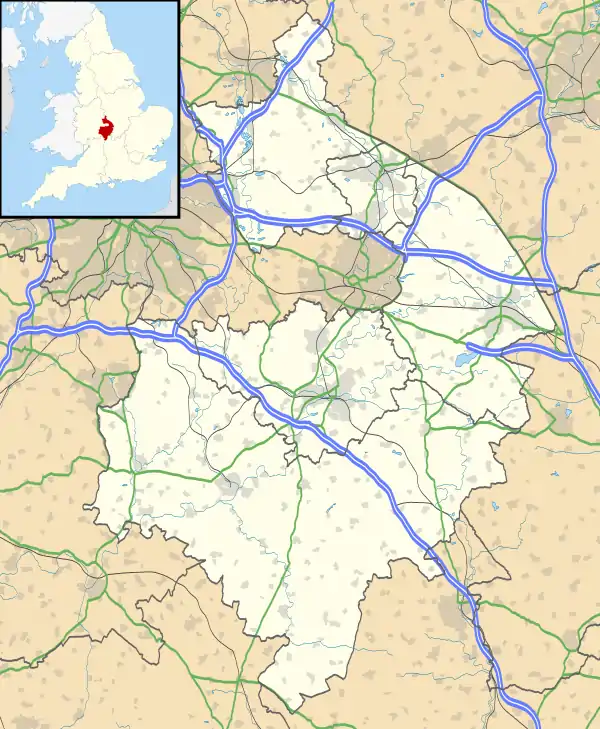St John's House Museum, Warwick
St John's House Museum is an historic house located in Warwick, just east of the town centre, in Warwickshire, England. It is now a museum, and has had a history spanning almost 900 years. To the side of the house is a small garden belonging to St John's and to the rear is the large St. Nicholas' Park. The museum is currently operated by Warwickshire Heritage and Culture's Museum Service, a branch of Warwickshire County Council. The current grade I listed building dates from around 1666, and is considered one of the most important building in Warwick.[1]
 | |
 Location within Warwickshire | |
| Established | 1960 |
|---|---|
| Location | Warwick, United Kingdom |
| Coordinates | 52.2832°N 1.5804°W |
| Website | heritage |
Historic Use
In the almost 900 years of its existence, St. John's House has had a wide and varied history. Many of its uses have been related directly to helping local people, particularly in the realms of health and education - a tradition which is continued today in its use as a free museum to educate the local community on the area's history.
As a hospital
In the mid 12th century, during the reign of Henry II, the land on which St. John's House stands was given to the establishment of the Hospital of St. John the Baptist. The hospital was brought into being by William de Beaumont, then Earl of Warwick. This hospital provided two purposes: To help the local poor and ill; and to provide casual overnight boarding and food to impoverished travelers such as pilgrims.[2] The Hospital of St. John the Baptist was one of two such hospitals in the town of Warwick at the time. The other was the Hospital of St. Michael, founded with the sole purpose of providing help and respite to those in the parish suffering from leprosy. Of both hospitals, only the chapel building of St. Michael still stands.[3]
In 1291's taxatio, the Hospital was noted to own a dovecote worth 2 shillings. Additionally, the carucate of land owned by the Hospital was valued at 10 shilling per year. In 1337, protection was granted to the hospital's brethren and their attorneys for the collection of alms at churches. At this time it was suggested that some building renovation was necessary.
It is known that in 1610 the site comprised four standing buildings, including a gatehouse topped with crenelations. The largest of the three other buildings has crosses at the roof's apex, suggesting its religious use as the site's chapel.[4] At the time the hospital site also included a cemetery - remains have often been dug up during refurbishment or remodeling works on the House. The first recorded case was in the 1830s when work was being undertaken in the kitchen garden. In 1987, two workmen digging to the Coten End front of St. John's Court flats discovered two skulls.[5]
As a residence
During the Dissolution of the Monasteries at the behest of Henry VIII, St. John's was granted to Anthony Stoughton, for services to the King. The land was later passed to his eldest son William by inheritance. Neither of the two lived in the house, but they leased it out to others such as Richard Townsende, a yeoman at Warwick. Eventually the land was inherited by the son of William Stoughton, Anthony Stoughton (junior), who built a house on the site. Of note is the fact that in the East Wing of the house there is a door lintel which bears the date 1626 and the initials A.S.. The house remained in the possession of the Stoughton family until 1960.[6]
As a school
In 1791, the building was rented out for the first time by the Earl of Warwick for public use, with the intent of converting it into a school. The school, then known as St John's Academy, was founded by William T Fowler and was set up as a school for "Young Gentlemen" (as advertised on the hand-bill[7] Throughout the life of the school, its cohorts changed frequently. In 1828, the daughters of William Fowler, then running the school, changed it to a school for girls. It was then reverted in 1845 under a Mr. Townsend. Then it returned to a girls' school in 1884, which continued until the very end of the 19th Century. In the later part of the school's life, as money became tighter, the school restricted itself to the lower part of the house, with upper rooms being leased out to local artists and other public figures, with their studios being open for public viewing. The school was declared bankrupt in 1900 and closed down.
As a public service
After a brief spell of private tenancy in the start of the 20th century, the house became property of the War Department, where it was used for the administration of the Home Counties and East Anglian Brigades. In 1959 the Lord Warwick declared sale of the Warwick Castle Estates, including the St. John's House. It was bought by Warwickshire County Council along with the Royal Regiment of Fusileers (Royal Warwickshire), who own it to this day. The building was then turned into a museum, with some of the premises leased to the Regiment. The museum was officially opened in 1960 by Bernard Montgomery, 1st Viscount Montgomery of Alamein.
The Museum
Now, the museum provides information about the history of the site, as well as Warwick and the surrounding area. Features of the museum include:
- A full-sized replica of a Victorian classroom, as it would have appeared during the educational period of St. John's House. The display includes benches and seating, charts and diagrams, as well as teaching tools such as abacuses and blackboards, all contemporary of the time. This display is designed to give people (young people in particular) an idea of what education would have been like in 19th century compared with now. The Museum currently runs activities based on this exhibit for schools.[8]
- The second floor houses a museum dedicated to the history of the Royal Warwickshire Fusiliers.[9]
- In 2011, the Museum Service established a themed outdoor space, St John's Brook Gardens, between St John's House Museum and St Nicholas' Park. This features woodcarving and information on natural history.
The museum is free and open to the public. The museum is located half a mile from the Market Square and the main bus station, and a short walk from Warwick railway station.[10]
References
- "St John's House A Grade I Listed Building in Warwick, Warwickshire". British Listed Buildings. Retrieved 26 September 2020.
- A detailed history of the hospital.
- Dugdale's History of Warwickshire
- Warwickshire County Record Office - 'The Ground plott of Warwick', in Dugdale, W. The Antiquities of Warwickshire, London, 424-5
- Archaeological Report 0446 Rev A July 2006, Warwickshire County Council records
- "A History of Warwick". Retrieved 11 January 2014.
- Poster for St John's Academy, Warwick, for the education of young gentlemen c.1800. Warwickshire Country Record Office (PV WAR St John 8)
- "H&CW Website - School Events". Retrieved 11 January 2014.
- "Royal Regiment of Fusiliers Museum (Warwickshire), St John's House, Warwick". Retrieved 30 January 2012.
- "Accessing St. John's Museum". Retrieved 11 January 2014.